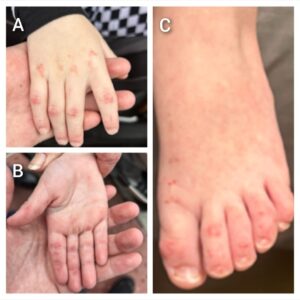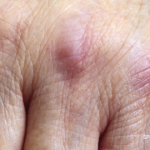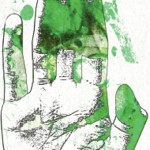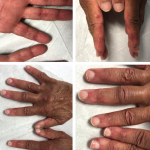For the 2024 Image Competition, the ACR sought images with educational or remarkable manifestations representing a diverse range of pediatric patients with autoimmune, inflammatory, infectious and malignant drivers of rheumatic disease. Here, we showcase the winning images from North America.
Patient Presentation
A 3-year-old boy presented with a four-month history of rash and hand blisters. On physical examination, the patient exhibited a heliotrope rash, Gottron papules (A), papules on the palmar creases of his fingers consistent with kissing papules (B), and erythematous desquamative plaques on the back of his toes (C).
Laboratory tests were positive for anti-melanoma differentiation-associated gene 5 (MDA-5) autoantibody, but normal muscle enzymes. Subtle myositis was evident on the magnetic resonance imaging (MRI) scan. High-resolution computed tomography (HRCT) of the chest was normal.
Kissing papules refer to papules occurring on the palmar creases of the fingers, forming symmetrical lesions on each side. It is one of the unique cutaneous characteristics of anti-MDA-5 dermatomyositis.
Learn More
For information about anti-MDA-5 dermatomyositis, read these articles from Arthritis & Rheumatology:
- Understanding the Role of Type I Interferons in Cutaneous Lupus and Dermatomyositis: Toward Better Therapeutics: https://acrjournals.onlinelibrary.wiley.com/doi/10.1002/art.42983
- Expert Perspective: Diagnostic Approach to Differentiating Juvenile Dermatomyositis from Muscular Dystrophy: https://acrjournals.onlinelibrary.wiley.com/doi/10.1002/art.43057
Eaman Alhassan, MD, is an inflammatory muscle disease (myositis) fellow at the University of Pittsburgh
Medical Center (UPMC). She earned her medical degree from King Saud University, Riyadh, Saudi Arabia,
completed her residency at the University of Maryland Medical Center, Baltimore, and completed a
rheumatology fellowship at the University of Southern California, Keck School of Medicine, Los Angeles.
About the Contest
The Rheumatology Image Library is a highly accessed teaching resource, and images from the ACR’s annual contest are added to it, helping keep it dynamic and current. Look for the Best Overall and regional winners in future issues and on our website.




